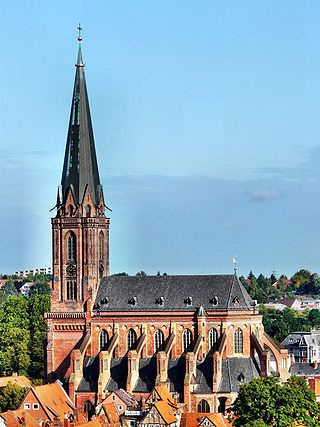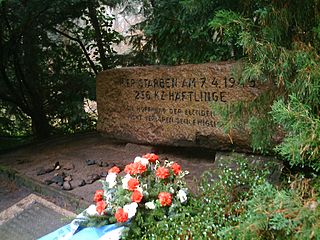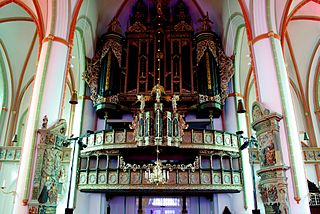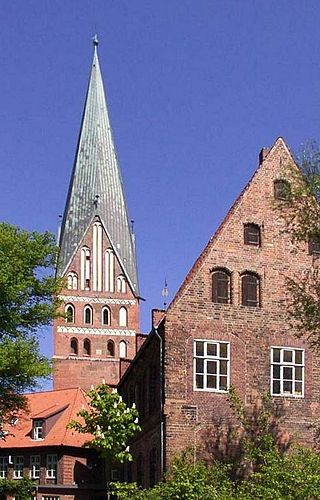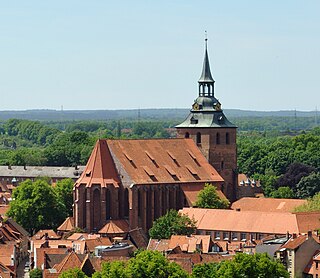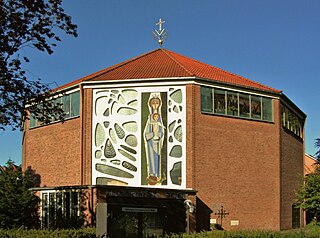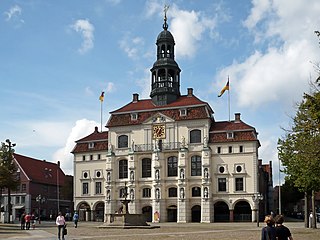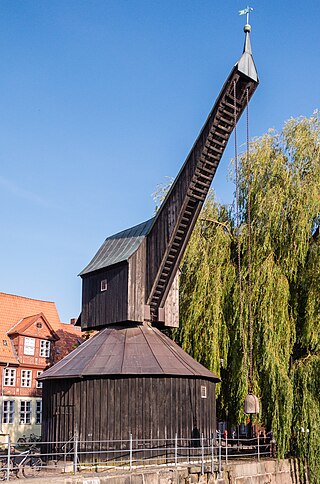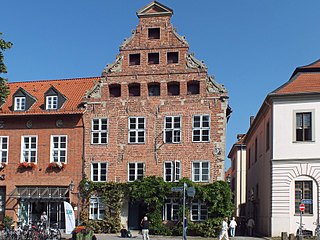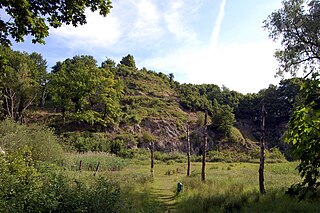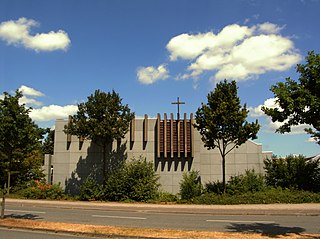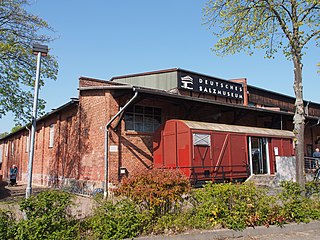15 Sights in Lüneburg, Germany (with Map and Images)
Legend
Explore interesting sights in Lüneburg, Germany. Click on a marker on the map to view details about it. Underneath is an overview of the sights with images. A total of 15 sights are available in Lüneburg, Germany.
Sightseeing Tours in Lüneburg1. Lüneburger Wasserturm
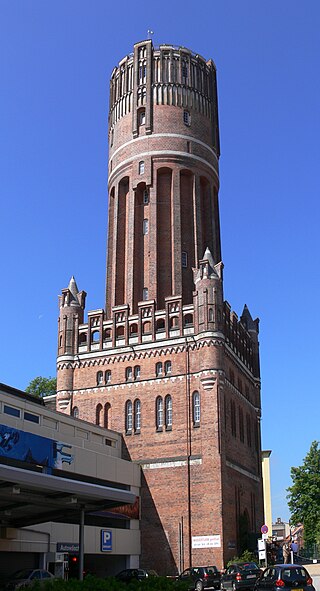
Lüneburg Water Tower is a water tower in the southeastern part of the Lüneburg old town in Lower Saxony, Germany, built by the architect Franz Krüger (1873–1936), from designs by Richard Kampf. Its erection was initiated on 3 October 1905, and the tower was taken into use in November 1907. The water tower is 55 metres (180 ft) tall, and is the tallest building in the Lüneburg old town that is not a church. It stands between the considerably newer Nordlandhalle and the Johanneum, the latter now used as a school. The tower consists of a square base of 18 metres (59 ft) and a round portion which is walled up around a 500 cubic metres (18,000 cu ft) large water tank. The upper part is carried by 16 solid columns.
2. St. Nicolai
St. Nicolai is a church and Lutheran parish in Lüneburg, Lower Saxony, Germany. It is one of three main churches in the town, all built in brick Gothic style. The church, dedicated to St. Nicholas, is a basilica with three naves, built from 1407 to 1440. It features a "star" rib vault that is unique in Northern Germany. When the Reformation was introduced in Lüneburg in 1530, the church became Lutheran. The high steeple was added in the 19th century.
Wikipedia: St. Nicolai, Lüneburg (EN), Website, Heritage Website
3. Ehrenmal für gestorbene KZ-Häftlinge
The memorial in the Tiergarten near Lüneburg railway station commemorates a mass grave of 256 concentration camp prisoners whose transport from a subcamp of the Neuengamme concentration camp in Wilhelmshaven was bombed on 7 April 1945. Up to 80 of the mostly injured and weakened prisoners, who could not be transported further, were shot by their guards on 11 April 1945 and are buried here together with the victims of the bombing raid.
4. Orgeln von St. Johannis
The organs of St. Johannis (Lüneburg) are the large historic main organ on the west gallery and the choir organ in the five-nave Gothic hall church of St. Johannis in Lüneburg. The large instrument received its present form mainly in 1553 and through the baroque extensions. Today, it has three manuals and 51 stops. In addition, there is a two-manual choir organ from the Kuhn company from 2010 with 23 stops in the church.
5. St. John's Church
The Church of John the Baptist is the oldest Lutheran church in Lüneburg, Germany. It is located in the city centre. Lüneburg is on the European Route of Brick Gothic and the church is an example of this style. With its 108-meter high spire, it is the second tallest church tower in Lower Saxony – after St. Andrew's in Hildesheim.
Wikipedia: St. John's Church, Lüneburg (EN), Website, Heritage Website
6. St. Michaelis
St. Michaelis is one of the main churches in Lüneburg, Lower Saxony, Germany. It was first an abbey church of the former monastery of Benedictines, built from 1376 in brick Gothic style. It became Lutheran during the Reformation. Johann Sebastian Bach was for two years a pupil at the school of St. Michaelis.
Wikipedia: St. Michaelis, Lüneburg (EN), Website, Heritage Website
7. St. Marien
Sankt Marien is a Roman Catholic church in Lüneburg, Lower Saxony, Germany. It is the parish church of the parish of St. Marien in the deanery of Lüneburg, bears the patronage of the Virgin and Mother of God, who was conceived without original sin, and stands on Friedenstraße in the Rotes Feld district.
8. Altes Rathaus
The Lüneburg Town Hall is the headquarters of the council and administration of the Hanseatic city of Lüneburg in Lower Saxony. The building complex was built around 1230 and has been expanded over the centuries. It is an example of medieval and early modern secular architecture in northern Germany.
9. Alter Kran
The Old Crane is a historic harbour crane at the former Ilmenau harbour in Lüneburg. Built in 1797, the crane, which at the time was one of the most powerful in the whole of northern Germany, still shapes the image of the water district today and is considered one of the city's landmarks.
10. Heinrich-Heine-Haus
The Heinrich-Heine-Haus in Lüneburg is a patrician house from the 15th/16th century, in which the parents of the poet Heinrich Heine lived. It is now used by municipal authorities and cultural institutions and contains a scholarship apartment for writers.
11. Alte Ratsapotheke
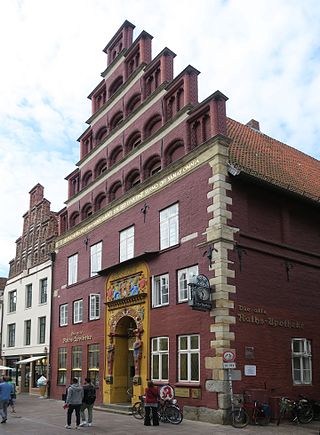
The Alte Ratsapotheke is a pharmacy in the historic center of the Hanseatic city of Lüneburg. The current building was completed in 1598 after extensive renovation work, it replaced a previous building from earlier centuries and is now a listed building.
12. Kalkberg
The Lüneburg Kalkberg is the cap rock of a salt dome in the western part of the German town of Lüneburg. The Kalkberg was a gypsum mine during the middle ages, but is today a Naturschutzgebiet and a common meeting place for city residents.
13. Theater Lüneburg
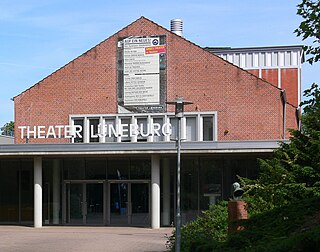
The Theater Lüneburg is a three-genre theatre in Lüneburg with its own ensembles for drama, music theatre and ballet. The venues are the Great House with 542 seats, the Studio T.NT with 99 seats and the Young Theatre T.3.
14. Ökumenisches Gemeindezentrum St. Stephanus
Sankt Stephanus is the ecumenical centre in Kaltenmoor, a district of the district town of Lüneburg in Lower Saxony, Germany. The institution, named after St. Stephen, has the address "St.-Stephanus-Platz 1".
15. Deutsches Salzmuseum
The German Salt Museum in the German town of Lüneburg, on the site of the old production facilities of the Lüneburg Saltworks when it was closed in 1980. In 1991, it won the Council of Europe Museum Prize.
Share
Disclaimer Please be aware of your surroundings and do not enter private property. We are not liable for any damages that occur during the tours.
